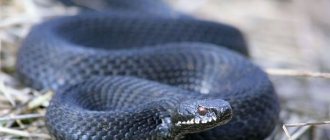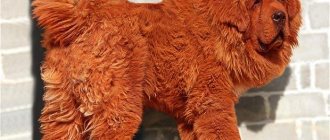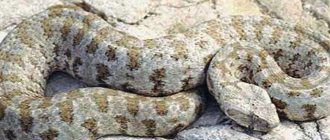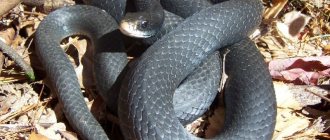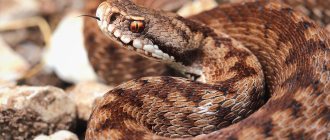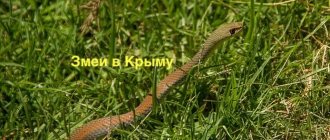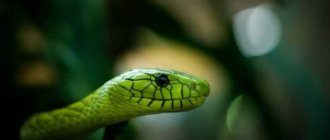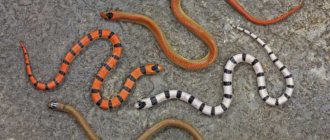Read in this article:
The viper is the most common species of snake in Russia.
If we talk about our fauna, there are not so many poisonous snakes in Russia: there are about 40 species, and about 11 are truly poisonous and dangerous to humans (the figure depends on the views of experts on the classification of species).
On the territory of our country, optimal conditions for them have been created only in the southern regions. The maximum diversity is in the Caucasus and the south of the Far East. The rest of Russia is sparsely populated by venomous snakes. The most common type of snake in our country is the common viper. “It has a gigantic range - from the Atlantic Ocean to the Pacific Ocean ,” says Igor Doronin, Candidate of Biological Sciences, senior researcher at the Zoological Institute of the Russian Academy of Sciences.
Common viper
It is poisonous, but its poison is weak, sufficient only to kill a mouse or frog, which this snake usually feeds on. The percentage of deaths from its bites in humans rarely reaches 0.5%. Children and the elderly are at risk. In addition, the common viper requires a lot of energy to reproduce venom, so it does not waste its resources without a good reason and attacks a person only in case of provocation.
Common viper.
Distinctive features of the common viper:
- length no more than 70 cm;
- zigzag pattern on the skin;
- triangular, spear-like, wide head;
- vertical pupils.
In our country you can find not only this representative, but also other species of the genus of real vipers.
Cottonmouth
On the territory of the Lower Volga region in the Far East, another species of viper lives - the copperhead. The peak of its activity occurs in the spring; at this time of year it behaves aggressively. It can kill a horse with its poison. It is less dangerous for a healthy adult, although its bite causes severe and prolonged pain. In sunny weather, the copperhead likes to sit out in the bushes, between stones, and in the burrows of field mice. There are many reasons for a person to linger in dense thickets. Even in these intimate moments, do not lose your vigilance. The cottonmouth may jump up and bite exposed areas of your body. Due to its brown and gray-brown color with small dark spots, it is not easy to notice.
Cottonmouth.
Classification
The dog-headed boa constrictor is a member of the Pseudopod family.
The noisy viper is a member of the Viper family.
The main groups of snakes are Scolecophidia (blind snakes, 1 superfamily) and Alethinophidia (all other snakes, 5 superfamilies). Sometimes they are given the rank of infra-detachments. Alethinophidia is divided into Caenophidia (higher and warty snakes) and Henophidia (all others).
According to The Reptile Database, as of February 2017, there were 3,631 known species of snakes. They are combined into more than 20 families and 6 superfamilies (4 families are not yet included in any superfamily). Venomous snakes make up about a quarter of known species.
- Family Aniliidae - Roll snakes
- Family Bolyeriidae - Mascarene boas, or bolyeriids
- Family Tropidophiidae - Ground boas
- Family Xenophidiidae
- Superfamily Acrochordoidea
Family Acrochordidae - Warty snakes - Superfamily Uropeltoidea
Family Anomochilidae - Family Cylindrophiidae - Cylindrical snakes
- Family Uropeltidae - Shield-tailed snakes
- Family Loxocemidae - Mexican ground pythons
Family Boidae - Pseudopods
- Family Colubridae - Colubridae
- Family Anomalepididae - American worm snakes
Fossil species
One of the extinct families of snakes is Madtsoiidae. Sanajeh indicus , found in 1987 and described in 2010
.
It lived about 67 million years ago (in the Maastrichtian age of the Cretaceous period) and was 3.5 meters long. Fossil remains of the shell were discovered along with his bones. This is the first evidence that snakes ate dinosaur eggs and babies. Najash rionegrina
, which lived in Argentina during the Cretaceous period, about 95 million years ago (Cenomanian), belongs to the same family Its remains were found in 2006.
Some extinct snakes have preserved rudiments of their hind limbs, for example, a representative of the pachyophyid family - Eupodophis descouensi
.
Caucasian viper and Dinnika's viper
Anyone who travels to the alpine belt or forests of the Western Caucasus may encounter the Caucasian viper and Dinnika's viper. Their poison is the most powerful. This is due to the fact that they live in rough terrain where it is easier for prey to hide. They need to kill the victim as quickly as possible so as not to crawl long distances after it in the mountains.
Caucasian viper.
These relict species of snakes are rarely seen today.
They are listed in the Red Book: encountering them is most likely on the territory of the Caucasus Nature Reserve, Sochi National Park, and Abkhazia. Caucasian vipers are very brightly colored: usually in red and lemon shades. The bite of this viper is extremely effective and painful. This is due to the structure of the mouth: the poison is secreted from the glands on the upper jaw and passes through the tubules into the long and hollow fangs. For example, the African Gaboon viper's teeth can reach 5 cm. During an attack by a viper, its mouth can be opened 180 degrees, the fangs are pushed forward. When a snake bites a victim, the muscles around the glands contract, thereby squeezing out the venom. It's like two syringes working. During normal times, this snake's fangs are folded back. The device of the viper's mouth resembles a penknife, the blades of which easily slide into the handle. In general, vipers are the most advanced venomous snakes; they have the most developed venomous apparatus ,” added Igor Igorevich.
Dinnik's viper.
Igor Doronin had the opportunity to catch vipers during expeditions. As life has shown, these snakes are not aggressive and behave quite peacefully. However, he himself tries not to touch them, much less catch them. After all, snakes regularly bite even those people who professionally catch them:
Snakes are strong animals. If you grab a snake by the chin, it can bite through its jaw to bite a person with its teeth.
How does brittle spindle feed?
The constant food of the spindles is the same slow, semi-underground lifestyle of slugs and earthworms. It is not difficult to find them in a damp place in the forest, so there is no need to crawl a lot and you do not need a large individual area. There is also no need to pursue and examine such prey. Having discovered the victim, the spindle does not rush the gay: it “sniffs” it with the help of its tongue, then begins to swallow it. At the same time, she periodically rubs her head on the ground, wiping mucus from food and from her muzzle. Eating large prey can last for half an hour or even longer. The sharp, curved back teeth of the spindle allow it to hold the slippery elastic body of the victim. They also help remove earthworms from their passages: gradually intercepting the body of the worm with its jaws, it slowly pulls it out entirely. If the worm clinging to the walls of the burrow with its bristles cannot be pulled out, the lizard unscrews the part that it has already grabbed. They repeatedly observed how two spindles, grabbing one worm from both ends, tore it in half, rotating the whole body around its axis - one clockwise, the other counterclockwise.
With the help of its back-curved teeth, the spindle even manages to pull snails out of their shells. To do this, she, resting her muzzle against the base of the shell, gradually intercepts the muscular “leg” of the snail with her jaws higher and higher. On occasion, the spindle can profit from millipedes, woodlice, and caterpillars. Since, like snakes, it can swallow large prey, occasionally other lizards, young lizards of the same species, and even snakes become its victims. The following fact is known: a spindle 29 centimeters long swallowed a young snake 18 centimeters long. There were no cases of eating vegetation.
Gyurza
The greatest danger in our fauna is the viper called the viper. It’s not for nothing that its old Russian name is the coffin snake. In Russia, it lives only in the territory of Dagestan. There it can be found in foothill and mountainous areas. In particular, in the area of the city of Derbent.
This is the largest viper of the Russian fauna, reaching 2 meters in length and weighing up to 3 kilograms. She has a wide head, and instead of a zigzag along the ridge, there is a spotted pattern on her skin. In addition, it can be recognized by its short tail, which immediately stands out against the background of its massive body.
Gyurza.
Like all venomous snakes, the viper has a cat-like, vertical pupil. This is due to the twilight-nocturnal lifestyle. Non-venomous snakes - grass snakes, snakes - have a round pupil. But it is unlikely that a person would look into its eyes during an encounter with a snake.

